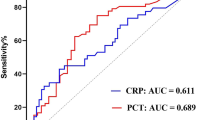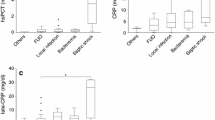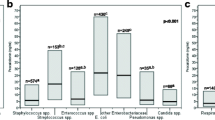Abstract
Procalcitonin (PCT) levels can distinguish between infectious and non-infectious systemic inflammatory response. However, there are some differences between Gram-negative (G−), Gram-positive (G+), and fungal bloodstream infections, particularly in different cytokine profiles, severity and mortality. The aim of current study was to examine whether PCT levels can serve as a distinguishing mark between G+, G−, and fungal sepsis as well. One hundred and sixty-six septic patients with positive blood cultures were examined on C-reactive protein (CRP) and PCT on the same date of blood culture evaluation. The median (interquartile range, IQR) of CRP and PCT in G+, G−, and fungal cohorts and comparison of measured values between groups were made using the Kruskal–Wallis test with subsequent Bonferroni’s corrections, with p < 0.05. In 83/166 (50 %) of blood cultures, G+ microbes, 78/166 (47 %) G− rods, and 5/166 (3 %) fungi were detected. PCT concentrations (ng/ml) were significantly higher in G− compared to other cohorts: 8.90 (1.88; 32.60) in G−, 0.73 (0.22; 3.40) in G+, and 0.58 (0.35; 0.73) in fungi (p < 0.00001). CRP concentrations did not differ significantly in groups. Significantly higher PCT levels could differentiate G− sepsis from G+ and fungemia. In contrast to CRP, PCT is a good discriminative biomarker in different bloodstream infections.


Similar content being viewed by others
References
Vincent JL, Sakr Y, Sprung CL, Ranieri VM, Reinhart K, Gerlach H et al (2006) Sepsis in European intensive care units: results of the SOAP study. Crit Care Med 34:344–353
ACCP-SCCM Consensus Conference (1992) Definitions of sepsis and multiple organ failure and guidelines for the use of innovative therapies in sepsis. Crit Care Med 1992(20):864–874
(2003) 2001 SCCM/ESICM/ACCP/ATS/SIS International Sepsis DefinitionsConference. Crit Care Med 31:4
Pierrakos CH, Vincent JL (2010) Sepsis biomarkers: a review. Cri Care 14(1):R15
Simon L, Gauvin F, Saint Louis P, Lacroix J (2004) Serum procalcitonin and C-reactive levels as markers of bacterial infection: a systematic review and meta-analysis. Clin Infect Dis 39:206–217
Reinhart K, Meisner M (2011) Biomarkers in the critically ill patient: procalcitonin. Crit Care Clin 27:253–263
Brunkhorst FM, Wegscheider K, Forycki ZF, Brunkhorst R (2000) Procalcitonin for early diagnosis and differentiation of SIRS, sepsis, severe sepsis and septic shock. Intensive Care Med 26:S148–S152
Reinhart K, Meisner M (2006) Markers for sepsis diagnosis: what is useful? Crit Care Clin 22:503–519
Gao H, Evans TW, Finney SJ (2008) Bench-to-bedside review: sepsis, severe sepsis and septic shock—does the nature of the infecting organism matter? Crit Care 12(3):213
Feezor RJ, Oberholzer C, Baker HV, Novick D, Rubinstein M, Moldawer LL et al (2003) Molecular characterization of the acute inflammatory response to infections with gram-negative versus gram-positive bacteria. Infect immune 7:5803–5813
Bjere A, Brusletto B, Holby EA, Kjerulf P, Brandtzaeg P (2004) Plasma Interferon gamma and interleukin 10 concentration in systemic meningococcal disease compared with severe systemic Gram-positive septic shock. Crit Care Med 32:433–438
Mohamed MA, Cunningham-Rundles S, Dean CR, Hammad TA, Nesin M (2007) Levels of proinflammatory cytokines produced from cord blood in vitro are pathogen dependent and increased in comparison to adult controls. Cytokine 39:171–177
Charles PE, Ladoire S, Aho S, Quenot JP, Doise JM, Prin S (2008) Serum procalcitonin elevation in critically ill patients at the onset of bacteremia caused by either gram negative or gram positive bacteria. BMC Infect Dis 8:38
Abe R, Oda S, Sadahiro T, Nakamura M, Hirayama Y, Tateishi Y (2010) Gram-negative bacteremia induces greater magnitude of inflammatory response than gram-positive bacteremia. Crit Care 14:R27
Martini A, Gottin L, Menestrina N, Schweiger V, Simion D, Vincent JL (2010) Procalcitonin levels in surgical patients at risk of candidemia. J Infect 60:425–430
Montagna MT, Coretti C, Caggiano P (2011) Procalcitonin: a possible marker of invasive fungal infection in high risk patients? J Prev Hyg 52:38–39
Vincent JL, Donadello K, Schmidt X (2011) Biomarkers in the critically ill patient: C-reactive protein. Crit Care Clin 27:241–251
Delevaux I, Andre M, Colombier M, Albuisson E, Meylheuc F, Bégueet RJ (2003) Can procalcitonin measurement help in differentiating between bacterial infection and other kinds of inflammatory processes? Rheum Dis 62:337–340
Acknowledgments
This work was supported by the Research Program P25 of Charles University in Prague.
Conflict of interest
Authors certify that they have no affiliation with or financial involvement with any organization or entity with a direct financial or any other interest in the subject matter or materials discussed in the manuscript.
Author information
Authors and Affiliations
Corresponding author
Rights and permissions
About this article
Cite this article
Brodská, H., Malíčková, K., Adámková, V. et al. Significantly higher procalcitonin levels could differentiate Gram-negative sepsis from Gram-positive and fungal sepsis. Clin Exp Med 13, 165–170 (2013). https://doi.org/10.1007/s10238-012-0191-8
Received:
Accepted:
Published:
Issue Date:
DOI: https://doi.org/10.1007/s10238-012-0191-8




